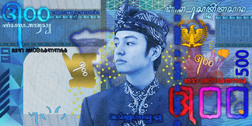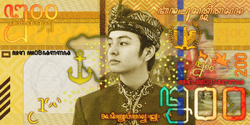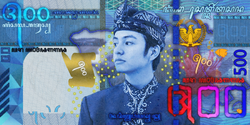Kertic Mas: Difference between revisions
mNo edit summary |
No edit summary |
||
| Line 31: | Line 31: | ||
| rarely_used_banknotes = ℳ 5 | | rarely_used_banknotes = ℳ 5 | ||
}} | }} | ||
The '''Kertic Mas''' (Kertic: ꦩꦱ꧀ꦏꦼꦂꦠꦱꦤ, ''"Mas Kêrtåsånå"'') is the national {{wp|currency}} of [[Kertosono]]. | The '''Kertic Mas''' (Kertic: ꦩꦱ꧀ꦏꦼꦂꦠꦱꦤ, ''"Mas Kêrtåsånå"'') is the national {{wp|currency}} of [[Kertosono]]. It is controlled and issued by the Central Bank of Kertosono with an ISO code of KRM. Originally a currency union between Kertic states, it was made a singular currency with a sungular monetary authority for all of Kertosono upon the creation and unification of Kertosono in 1901. It was decimalized in 1976 when 360 old pesers formed into 100 new pesers. The Kertic Mas is the sole official legal tender within Kertosono, as the use of any other currency as a medium of exchange within the country has been made illegal since 2004. | ||
The Mas was originally known as the standard currency as a currency union between 12 Kertic states in 1878, one of which included the Kingdom of Ngawi. The curency union mandated the issuance of the same weights in silver and gold, as well as a unified monetary policy, sparking the beginnings of the modern Kertic Mas and its institutions. Upon unification, the Mas along with the standardized weights in silver and gold were carried on with slight modifications to accomodate most of the eastern states which were new to the currency union. The Common Currency Board of Eastern Kertosono became was the predecessor to the Central Bank of Kertosono, becoming the official institution for the country in 1902, one year after the adoption of the Mas. In 1957, the silver and gold standard was abandoned, and the currency wholly became a {{wp|fiat currency}}. | |||
==Banknotes== | |||
Banknotes of the Kertic Mas are usually released once every nine years or when a new monarch is installed. There have been 14 banknote series from 1901, with the latest release being in 2021 with the death of the late Emperor Mulawarman and the installment of his son Adityawarman III. It has been tradition that all banknotes feature the portrait of the monarch on the obverse side, and another important figure in the reverse. | |||
With the death of the Kertic Emperor Mulawarman VII, the Central Bank of Kertosono released new banknotes and issues for the regnal era of Adityawarman III. Incidentally, the first redesign for Mulawarman VII's banknote series was due for 2021. His portraits were removed from the banknotes and refitted with his son's image in preparation for his official coronation sometime in 2022. Only the 200 and 500 Mas denominations have been released as of 2021. | |||
==Gallery== | |||
{{Gallery | |||
| title = Kertic Mas | |||
| align = center | |||
| footer = | |||
| style = | |||
| state = | |||
| height = | |||
| width = 250 | |||
| captionstyle = | |||
| File:200Kerticmas.png | |||
| 200 Kertic Mas, 2021 | |||
| File:MasKertosono.png | |||
| 500 Kertic Mas, 2021 | |||
}} | |||
[[Category:Kertosono]] | [[Category:Kertosono]] | ||
Revision as of 08:43, 14 November 2021
| Kertic Mas | |
|---|---|
| ꦩꦱ꧀ Mas (Kertic) | |
 11th Mas series released for Adityawrman III (2021) | |
| Denominations | |
| Subunit | |
| 1/100 | Peser |
| Plural | p |
| Symbol | ℳ |
| Banknotes | |
| Freq. used | ℳ 10, 20, 50, 100, 200, 500 |
| Rarely used | ℳ 5 |
| Coins | |
| Freq. used | 5, 10, 25, 50p ℳ 1, 2, 5 |
| Rarely used | 1, 2p |
| Demographics | |
| Date of introduction | 18 June 1902 |
| User(s) | Kertosono |
| Issuance | |
| Central bank | Central Bank of Kertosono |
| Valuation | |
| Inflation | 1% |
The Kertic Mas (Kertic: ꦩꦱ꧀ꦏꦼꦂꦠꦱꦤ, "Mas Kêrtåsånå") is the national currency of Kertosono. It is controlled and issued by the Central Bank of Kertosono with an ISO code of KRM. Originally a currency union between Kertic states, it was made a singular currency with a sungular monetary authority for all of Kertosono upon the creation and unification of Kertosono in 1901. It was decimalized in 1976 when 360 old pesers formed into 100 new pesers. The Kertic Mas is the sole official legal tender within Kertosono, as the use of any other currency as a medium of exchange within the country has been made illegal since 2004.
The Mas was originally known as the standard currency as a currency union between 12 Kertic states in 1878, one of which included the Kingdom of Ngawi. The curency union mandated the issuance of the same weights in silver and gold, as well as a unified monetary policy, sparking the beginnings of the modern Kertic Mas and its institutions. Upon unification, the Mas along with the standardized weights in silver and gold were carried on with slight modifications to accomodate most of the eastern states which were new to the currency union. The Common Currency Board of Eastern Kertosono became was the predecessor to the Central Bank of Kertosono, becoming the official institution for the country in 1902, one year after the adoption of the Mas. In 1957, the silver and gold standard was abandoned, and the currency wholly became a fiat currency.
Banknotes
Banknotes of the Kertic Mas are usually released once every nine years or when a new monarch is installed. There have been 14 banknote series from 1901, with the latest release being in 2021 with the death of the late Emperor Mulawarman and the installment of his son Adityawarman III. It has been tradition that all banknotes feature the portrait of the monarch on the obverse side, and another important figure in the reverse.
With the death of the Kertic Emperor Mulawarman VII, the Central Bank of Kertosono released new banknotes and issues for the regnal era of Adityawarman III. Incidentally, the first redesign for Mulawarman VII's banknote series was due for 2021. His portraits were removed from the banknotes and refitted with his son's image in preparation for his official coronation sometime in 2022. Only the 200 and 500 Mas denominations have been released as of 2021.

